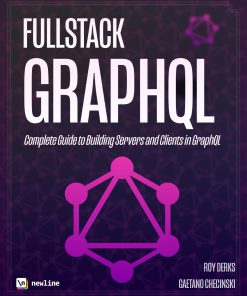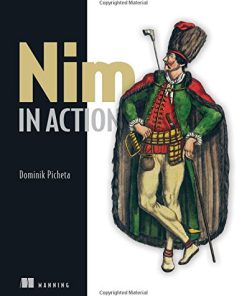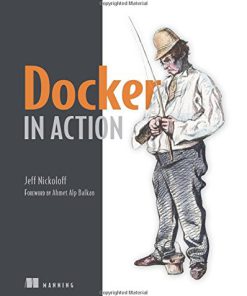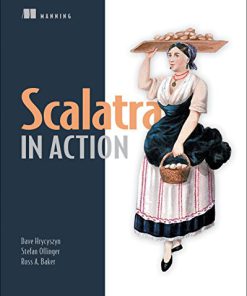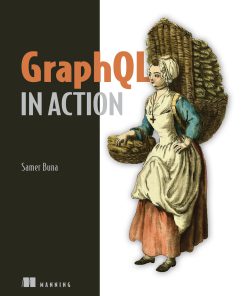GraphQL in Action 1st Edition by Samer Buna ISBN 161729568X 978-1617295683
$50.00 Original price was: $50.00.$25.00Current price is: $25.00.
GraphQL in Action 1st Edition by Samer Buna – Ebook PDF Instant Download/Delivery:161729568X ,978-1617295683
Full download GraphQL in Action 1st Edition after payment
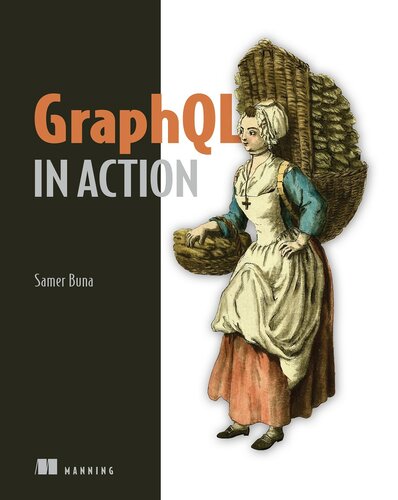
Product details:
ISBN 10: 161729568X
ISBN 13: 978-1617295683
Author: Samer Buna
Practical and example-driven, GraphQL in Action gives you the tools to get comfortable with the GraphQL language, build and optimize a data API service, and use it in a front-end client application. By working through set up, security, and error handling, you’ll lean to create a complete GraphQL server. You’ll also unlock easy ways to incorporate GraphQL into your existing codebase so you can offer simple, efficient, and scalable data APIs.
Reduce bandwidth demands on your APIs by getting only the results you need–all in a single request! The GraphQL query language simplifies interactions with web servers, enabling smarter API queries that can hugely improve the efficiency of data requests. In GraphQL in Action, you’ll learn how to bring those benefits to your own APIs, giving your clients the power to ask for exactly what they need from your server, no more, no less.
GraphQL In Action teaches everything you need to get started with GraphQL–from design principles and syntax right through to performance optimization. When you’re done, you’ll have all the skills you need to get started writing and using scalable data APIs with GraphQL
Purchase of the print book includes a free eBook in PDF, Kindle, and ePub formats from Manning Publications.
Table of contents:
Part 1 Exploring GraphQL 1
1 Introduction to GraphQL 3
1.1 What is GraphQL? 4
The big picture 5
GraphQL is a specification 9
GraphQL is a language 9
GraphQL is a service 11
1.2 Why GraphQL? 14
What about REST APIs? 17
The GraphQL way 18
REST APIs and GraphQL APIs in action 20
1.3 GraphQL problems 25
Security 25
Caching and optimizing 26
Learning curve 28
2 Exploring GraphQL APIs 30
2.1 The GraphiQL editor 31
2.2 The basics of the GraphQL language 36
Requests 36
Fields 39
2.3 Examples from the GitHub API 41
Reading data from GitHub 41
Updating data at GitHub 43
Introspective queries 44
Customizing and organizing GraphQL operations 47
3.1 Customizing fields with arguments 48
Identifying a single record to return 48
Limiting the number of records returned by a list field 49
Ordering records returned by a list field 51
Paginating through a list of records 51
Searching and filtering 53
Providing input for mutations 54
3.2 Renaming fields with aliases 55
3.3 Customizing responses with directives 57
Variables and input values 58
The @include directive 61
The @skip directive 62
The @deprecated directive 63
3.4 GraphQL fragments 63
Why fragments? 63
Defining and using fragments 64
Fragments and DRY 65
Fragments and UI components 66
Inline fragments for interfaces and unions 71
Part 2 Building GraphQL APIs 75
4 Designing a GraphQL schema 77
4.1 Why AZdev? 77
4.2 The API requirements for AZdev 78
The core types 80
4.3 Queries 82
Listing the latest Task records 82
Search and the union/interface types 84
Using an interface type 87
The page for one Task record 88
Entity relationships 90
The ENUM type 91
List of scalar values 92
The page for a user’s Task records 92
Authentication and authorization 93
4.4 Mutations 94
Mutation input 96
Deleting a user record 98
Creating a Task object 99
Creating and voting on Approach entries 100
4.5 Subscriptions 102
4.6 Full schema text 103
4.7 Designing database models 103
The User model 104
The Task/Approach models 105
The Approach Details model 107
Implementing schema resolvers 110
5.1 Running the development environment 110
Node.js packages 113
Environment variables 113
5.2 Setting up the GraphQL runtime 113
Creating the schema object 115
Creating resolver functions 116
Executing requests 117
5.3 Communicating over HTTP 119
5.4 Building a schema using constructor objects 122
The Query type 123
Field arguments 125
Custom object types 127
Custom errors 129
5.5 Generating SDL text from object-based schemas 132
The schema language versus the object-based method 134
5.6 Working with asynchronous functions 135
Working with database models and relations 138
6.1 Running and connecting to databases 139
6.2 The taskMainList query 141
Defining object types 142
The context object 143
Transforming field names 147
Transforming field values 150
Separating interactions with PostgreSQL 152
6.3 Error reporting 154
6.4 Resolving relations 156
Resolving a one-to-one relation 157
Resolving a one-to-many relation 166
Optimizing data fetching 171
7.1 Caching and batching 172
The batch-loading function 175
Defining and using a Data-Loader instance 177
The loader for the approachList field 179
7.2 Single resource fields 182
7.3 Circular dependencies in GraphQL types 187
Deeply nested field attacks 188
7.4 Using DataLoader with custom IDs for caching 190
The taskMainList field 190
The search field 193
7.5 Using DataLoader with MongoDB 199
8 Implementing mutations 208
8.1 The mutators context object 209
8.2 The Mutation type 211
8.3 User mutations 211
The userCreate mutation 211
The userLogin mutation 217
8.4 Authenticating API consumers 221
The me root query field 226
8.5 Mutations for the Task model 232
8.6 Mutations for the Approach model 235
The approachCreate mutation 236
The approachVote mutation 244
8.7 The userDelete mutation 246
Part 3 Using GraphQL APIs 251
9 Using GraphQL APIs without a client library 253
9.1 Using a web UI library 254
9.2 Running the web server 255
9.3 Making Ajax requests 258
9.4 Performing GraphQL query requests 260
Using GraphQL fragments in UI components 263
Including variables in requests 265
9.5 Performing GraphQL mutation requests 269
The login/signup forms 269
Handling generic server errors 273
Authenticating GraphQL requests 277
The Create Task form 278
The Create Approach form 281
Voting on an Approach 286
9.6 Performing query requests scoped for a user 287
The Search form 289
9.7 Next up 291
10 Using GraphQL APIs with Apollo client 293
10.1 Using Apollo Client with JavaScript 294
Making a query request 295
Making a mutation request 300
10.2 Using Apollo Client with React 303
Using the query and mutate methods directly 303
Including authentication headers 306
Using Apollo hook functions 309
Using the automatic cache 316
Manually updating the cache 317
Performing operations conditionally 321
10.3 Managing local app state 326
10.4 Implementing and using GraphQL subscriptions 332
Polling and refetching 332
Implementing subscriptions 334
Apollo Server 340
Using subscriptions in UJs 342
People also search for:
graphql in 100 seconds
graphql explained in 100 seconds
github graphql actions
graphql.kickstart.execution.graphqlrequest
Tags: Samer Buna, GraphQL in Action, Action 1st
You may also like…
Computers - Web Development
Computers - Programming
Computers - Hardware
Akka in Action 1st Edition Raymond Roestenburg 1638352933 9781638352938
Computers - Programming
Docker in Action 1st Edition by Jeff Nickoloff ISBN 1633430235 978-1633430235
Computers - Web Development
GraphQL in Action 1st Edition by Samer Buna ISBN 161729568X 978-1617295683
Computers - Programming
Computers - Programming
Scalatra in Action First Edition by Dave Hrycyszyn 1617291293 9781617291296
Computers - Networking




